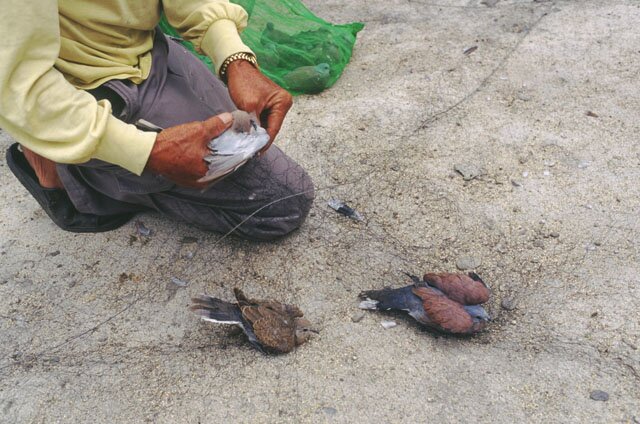BROWSE COUNTRIES/ TERRITORIES
What a tiger means to you
It says a lot about the tigers in the 21st century that it is an occasion of joy in some quarters when a wild tiger kills a human being.
In 2003 a Siberian Tiger killed and ate a worker in the wildlife park in Jilin, a north-eastern province of China. The reaction to the news was mixed. On the one hand it was a tragedy. That the worker might have ignored safety regulations does not disguise the fact that a human life had been lost. But it also showed the once-beleaguered Siberian tigers—the biggest of the cat family, a symbol of power and virility—were beginning to reassert their presence in their native habitat. For those who had worked long and hard to prevent the extinction of the tiger, this had to be viewed as good news.
Tigers are fast going the way of the dinosaurs. A hundred years ago more than 100,000 tigers of nine sub-species roamed the jungles and mountains of Asia. Today less than 6,000 survive in the open—one for every million men, women and children on earth. Over-hunting and human encroachment into their habitats have reduced the king of the beast to a pathetic creature.
More tigers now exist in captivity than in the wild. Many are treated badly. The exact number is hard to determine. Conservatively there are about 15,000 tigers in cages, 90 per cent of them in miserable roadside zoos, backyard breeder facilities, circus wagons and pet homes.
In captivity tigers do not fare well. They lose their hunting skills. They seldom socialise with their kind. They are confined to a small place. With a lifespan that goes up to 20 years, many die before they are 10. Some attack their captors.
In 2003 a man in New York City was mauled by the tiger he illegally kept in his apartment. He landed in the hospital, the tiger was sent to a zoo. In the same year, Roy Horn, half of the long-running Las Vegas double show of Siegfried and Roy, was attacked in front of a sold out crowd by his 550-lb (250kg) white Bengal Tiger. Roy, now 62, suffered a stroke and is only learning to walk unassisted in recent months. (White tigers, which can never survive in the wild, are the result of severe inbreeding.)
The tiger sits on the top of the food chain; it has no predators except mankind. If the tiger disappears from the wild, it can trigger a mass extinction of other species. Preserving the tiger would go a long way to ensure the survival of entire eco-systems.
There are nine sub-species of tigers. Three have become extinct (see box). Efforts to save the remaining six are spotty and uncoordinated. India has set up wildlife reserves to save the Bengal tiger, its national animal, as early as 1973. But illegal poaching has reduced the number from 40,000 in 1947 to 3,500 today. A frustrated writer in Delhi has suggested legal culling is the only way to ensure the survival of the Bengal Tiger.
In China, efforts are mostly confined to preserve the Siberian Tiger. Two wildlife parks are set up in the north-east provinces, where a few hundred tigers now roam. Some wild Siberian tigers are also seen roaming in the area.
Down south in the Fujian province, the Chinese Tiger (or South China or Xiamen Tiger) is being driven to extinction. Each tiger needs an average of 30 sq km of land for hunt. With 40 million people in Fujian, there is simply no place for the beast. A century ago there were 4,000 tigers in the province. Today there only 62 of them, all in captivity. The Fujian government has set up a $2 million reserve park for the tigers. But at 4.6 sq km, the land is too small for them to thrive.

In steps Li Quan, the controversial tiger lady. The 46-year Li was born in China in the Year of the Tiger. She took her bachelor’s degree in the Beijing University, and did a double masters, MBA and MA, in the Wharton Business School in the US. Li, who used to design her own clothes as a teenager, gravitated naturally to the fashion industry and eventually became Gucci’s worldwide head of licensing. Then she fell in love with tigers.
Nearing 40, Li traded her Guccis for khakis. With no experience in animal conservation, she started the Save Chinese Tiger (SCT) movement with her husband Stuart Bray, whom she met at Wharton. So far the couple has put in $8 million. Bray, an investment banker who took a break from Bankers Trust, has since returned to the financial industry.
SCT was launched in the Chinese embassy in London in October 2000. It was later registered in Hong Kong and the US. It has the support of the Chinese government, represented by the State Forestry Administration (SFA), as well as some scientists and naturalists. Many others in the tiger field, including the pioneer Peter Jackson, have opposed her efforts.
In 2002 Li launched the Chinese Tiger South Africa Trust, which serves as the branch of SCT on conservation efforts. The trust is to undertake one of the most audacious undertakings of the tiger movement: she aims to transport Chinese tiger cubs from China to South Africa, where they will be taught to regain their instinct for hunting and survival, after which the grown tigers will be brought back to a large reserve in China.
Li draws her inspiration from Africa’s wildlife reserves. She has secured a large tract of land in South Africa’s Laohu Valley Reserve. It is divided into two camps: a 76-ha training camp where the cubs are taught to socialise with their own kind and to hunt increasingly larger animals; and a larger 6,000 ha camp, surrounded by fences, where they will be set free to grow to their full size. After which they will be taken back to China.
China has agreed to work with Li. It will send her five to 10 cubs from 2003 to 2007 for breeding and ‘rewilding’. It will also provide up to 20,000 ha of land, possibly in Fujian, to set up a wildlife reserve for the tiger returnees.
“The land,” said Li, is “big enough for the survival of at least one population of tigers.”
Despite this, her plan is full of potential disasters. All her cubs come from the same bloodline. This may create problems of inbreeding. Inbreeding has led to deformity in some Siberian tiger cubs in the Heilongjiang tiger park. It could be more severe among the Chinese tigers, which come from a smaller genetic base.
But Li said her advisors—top cat biologists Drs Gary Koehler, Urs Breitenmoser and Roger Colinson—have told her it is premature to say genetic inbreeding will lead to the extinction of the entire species. The cheetahs are thriving today. But all of them come from five or six ancestors 10,000 years ago. Li is hopeful the same could happen to the Chinese tigers.
There are concerns that tigers are not suited for survival in South Africa. One of the first two cubs to be transplanted, Hope, died last year of pneumonia and heart failure. Hope, a four-year-old male, and its mate Cathay (named after Cathay Pacific, the airline which transported the animals), were sent from Chinese zoos to South Africa in 2003. Two more, TigerWoods and Madonna, were sent in 2004. Efforts are now being made to get Cathay to mix with the other two tigers.
Should the tigers breed successfully in South Africa, they will face another set of adjustment issues when they are returned to China. In fact, there may not even be a place for them back home. Land clearance is now a hot political issue in China, often leading to unrest and riots. Even with the best of intentions, the State Forestry Administration may find it difficult to fulfil its promise to provide a large reserve park for the tigers.
Li knows very well the problems ahead. Recently, she successfully persuaded celebrities to support the cause of the Chinese tiger.
The latest to join her camp is Jackie Chan, the gongfu actor. Chan, one of the most famous faces in China, now proclaims that “the Chinese tiger symbolises both Chinese culture and the international Olympic spirit.”
Li Quan has been trying unsuccessfully to get the tiger to be adopted as a mascot for the 2008 Olympics to be held in Beijing. (For some reason, both the tiger and the dragon lost out to the five chosen mascots: a highly stylised panda, a Tibetan antelope, a carp, a swallow and the Olympic flame.)
Now, with Jackie Chan on her side, Li stands a good chance of getting the tiger officially recognised at the Olympics. This will go a long way to promoting the cause of the Chinese Tiger.
From the tip of its nose to the end of its tail, the tiger plays a big role in traditional Eastern medicine. The following is a list of various tiger parts and their supposed curative properties:
1. Tiger teeth—to treat fever
2. Tiger fat—to treat leprosy and rheumatism
3. Nose leather—to treat superficial wounds such as bites
4. Tiger bone—to treat rheumatism, arthritis, general weakness, headaches, stiffness or paralysis primarily in the lower back and legs, and dysentery
5. Tiger heart—to impart strength, courage, and cunning
6. Tiger brains—mixed with oil and rubbed over body to cure laziness and acne
7. Tiger eyeballs—to treat epilepsy and malaria
8. Tiger whiskers—to give protection from bullets, impart courage, and prevent toothache
9. Tiger tail—to treat skin diseases
10. Tiger penis—to boost virility
Login or Register
 Lee Han Shih is the founder, publisher and editor of asia! Magazine.
Lee Han Shih is the founder, publisher and editor of asia! Magazine.
- Asian Dynasties and History
- Conservation of the Environment
- Definition: Culture
- Economy and Economics
- Food and Recipe
- Geopolitics and Strategic Relations
- Health and Body
- Of Government and Politics
- Religion and Practices
- Social Injustices and Poverty Report
- Society, Class and Division
- Unrest, Conflicts and Wars

































 Another Point
Another Point From Jerusalem to the West Bank
From Jerusalem to the West Bank
Comments
Post new comment